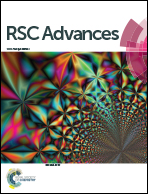Insight into composition evolution in the synthesis of high-performance Cu/SiO2 catalysts for CO2 hydrogenation†
Abstract
High-performance catalysts are the key factor for CO2 activation and conversion. In this paper, we systematically investigate the whole composition evolution process of Cu/SiO2 catalysts for CO2 hydrogenation. The precursor gradually evolved from amorphous Cu species to copper phyllosilicate, then to CuO with the increase of calcination temperature from ambient temperature to 700 °C. With the evolution of the precursor, the corresponding species after reduction were gradually evolved from Cu0 to Cu+, then to Cu0 again. The ratios of Cu+/(Cu+ + Cu0) are positively correlated with the catalytic activities. The Cu+ species derived from copper phyllosilicate were demonstrated to be crucial in achieving high-performance Cu/SiO2 catalysts for CO2 hydrogenation. The composition evolution has been demonstrated to be an efficient strategy to synthesize high-performance catalysts. This strategy of composition evolution can be applied to the synthesis of other high-performance Cu-based heterogeneous catalysts.


 Please wait while we load your content...
Please wait while we load your content...